

Lok-N-Blok - Designing a better way to build. Leader in AAC Panel Production Technology. Cooperate with SYSTEM 3E construction technology. Zbuduj ekologiczny dom szybko i prosto z DOM 3E. Dale's Marvellous Inventions and Adaptations. (natural building forum at permies) I've done some more internet surfing regarding the thermal properties of charcoal and come up with many more questions than answers.
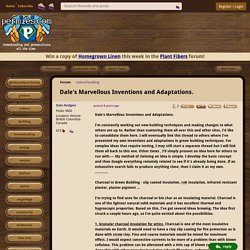
It turns out that much of the positive reports come out of China and were written in order to sell charcoal infused fabrics. The charcoal was derived from bamboo. Quite a bit of cross checking has convinced me that the radiant barrier thing is quite verifiable. But outside of advertising materials, I can find nothing on the conductive nature of granular charcoal alone. Various tables show that various forms of carbon are all over the map thermally and electrically. Other carbon materials have different rates of transfer at different temperatures. tBJ:The use of biochar as building material. Biochar is made by heating biomass to a temperature of 400 – 800°C under the absence of oxygen.
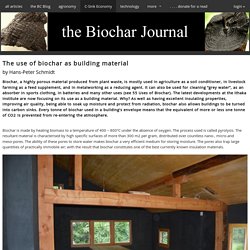
The process used is called pyrolysis. The resultant material is characterised by high specific surfaces of more than 300 m2 per gram, distributed over countless nano-, micro-and meso-pores. The ability of these pores to store water makes biochar a very efficient medium for storing moisture. The pores also trap large quantities of practically immobile air; with the result that biochar constitutes one of the best currently known insulation materials.
What If You Could Insulate Your House With Toast? Profile joints. Strong - Stylish - Quick assembly Topclamp projects go international!
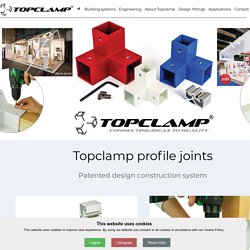
Topclamp is very suitable for large technical projects due to its simple assembly and experienced engineers. Miljövänligt tryckimpregnerat virke med hög hållbarhet I OrganoWood. Mycologist Develops Fungi Bricks That Grow Stronger Than Concrete. By Eden Marie Truth Theory This mycologists figured out how to make bricks made from growing fungi that are super-strong and water-, mold- and fire resistant.
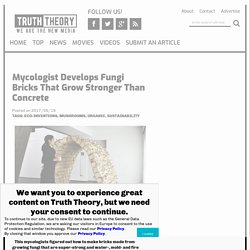
To most people, mushrooms are a food source. To mycologist (mushroom scientist) Philip Ross, fungi are much, much more. Oryzatech: Strawbale Lego Blocks for Grown-ups. Strawbale Building is one of those endeavours that mostly flies below the radar.
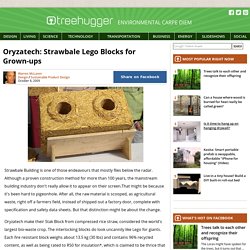
Although a proven construction method for more than 100 years, the mainstream building industry don't really allow it to appear on their screen.That might be because it's been hard to pigeonhole. After all, the raw material is scooped, as agricultural waste, right off a farmers field, instead of shipped out a factory door, complete with specification and safety data sheets. Air Crete Machine for Under $30 (DIY) DIY Low Cost Tiny Home made of Air crete. Domy z konopi – Ekocentrycy. Użycie konopi włóknistych w budownictwie ma swoją długą tradycję.
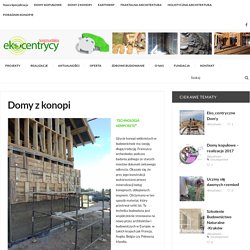
Francuscy archeolodzy podczas badania jednego ze starych mostów dokonali ciekawego odkrycia. Okazało się, że przy jego konstrukcji wykorzystano proces mineralizacji łodyg konopnych, oblepianych wapnem. Mycologist Develops Fungi Bricks That Grow Stronger Than Concrete - TruthTheory. Mycelia + Sawdust = House? Take a guess.
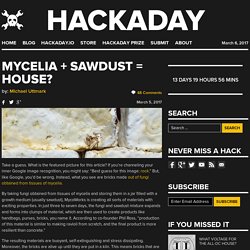
What is the featured picture for this article? Ecovative. Innovative Window System by Vitrocsa. Floor to ceiling windows are every designer’s dream and everyone living in a flat would enjoy such an abundance of light.
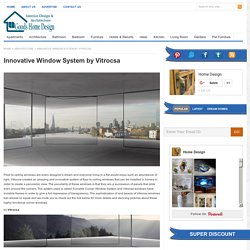
Vitrocsa created an amazing and innovative system of floor to ceiling windows that can be installed in homes in order to create a panoramic view. The peculiarity of these windows is that they are a succession of panels that slide even around the corners. The system used is called Turnable Corner Window System and Vitrocsa windows have invisible frames in order to give a full impression of transparency. The sophistication of and beauty of Vitrocsa windows has almost no equal and we invite you to check out the link below for more details and stunning pictures about these highly functional corner windows. Aerogel. High-quality particulate silica aerogel enables best-in-class solutions for energy-efficient buildings and industrial infrastructure, safe-to-touch surfaces, personal care products and more.

Aerogel, known as the “world’s best insulating solid material,” is used to enhance the thermal performance of energy-saving materials and sustainable products for buildings, on- and off-shore industrial infrastructure and consumer products, as well as acting as a high performance additive to coatings and personal care offerings. Our product line enables a wide range of product forms and applications, including: We are the global leader in producing high quality particulate silica aerogel. We are the only company to develop a commercialized process that allows continuous production of aerogel under ambient conditions. Best in thermal insulation. Upcoming Events European Coatings Show. Product Scorecard - Cradle to Cradle Products Innovation Institute. Renewal date 19 June 2017 Manufacturer Description Mushroom® Materials are a bio-based alternative to expanded plastic foams and other materials.
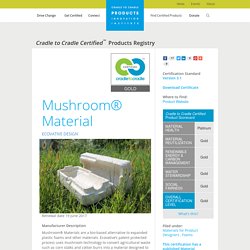
Ecovative’s patent protected process uses mushroom technology to convert agricultural waste such as corn stalks and cotton burrs into a material designed to be home compostable. Ecovative Design uses mycelium (mushroom “roots”) to bond together crop byproducts such as seed husks or stalks. The mycelium growing process happens indoors, in the dark, in less than a week. Ecovative Mushroom® Material. Reclaimed Bark Siding & High-End Wall Paneling. Metabolic Materials as a Measure of Architectural Quality. By Rachel Armstrong Between the 1830’s to 1840’s, the modern public health movement was started in Britain when Edwin Chadwick, advocate for the Poor Law, brought his vision of public health through sanitarianism into being through public works. This ultimately resulted in the construction of modern day water and sewage systems that set standards of urban infrastructure throughout the developed world.
Today we are facing a similar urban crisis of environment due to the consequences of living in industrial pollution for the last 150 years. This crisis, like the situation in the 1830’s, is directly related to our development and predilection for cities, which is only set to increase. Since the industrial revolution we have established a new relationship with technology that has prioritized the industrial landscape over the natural environment, leading to a toxic relationship between human activity and the land. Creating 'Living' Buildings. The University of Greenwich's School of Architecture & Construction is poised to use ethical synthetic biology to create 'living' materials that could be used to clad buildings and help combat the effects of climate change. Researchers from the University of Greenwich are collaborating with others at the University of Southern Denmark, University of Glasgow and University College London (UCL) to develop materials that could eventually produce water in desert environments or harvest sunlight to produce biofuels.
In collaboration with an architectural practice and a building materials' manufacturer, the idea is to use protocells -- bubbles of oil in an aqueous fluid sensitive to light or different chemicals -- to fix carbon from the atmosphere or to create a coral-like skin, which could protect buildings. All-black house in Poland is clad in sustainably harvested durable ThermoWood. Here at Inhabitat, we're all about new advancements when it comes to design. That's why we are so excited about an interesting technology coming from Scandinavia called ThermoWood, a sustainably harvested, extremely durable type of timber manufactured in Finland. Design studio też architekci chose ThermoWood as cladding material for their new residential project in Poland, prompting Treehugger's Lloyd Alter to take a closer look at the product, which combines benefits of both hardwoods and softwoods and offers an interesting alternative to the often hazardous chemically treated wood.
We’ve seen some great new developments in the field of sustainable cladding materials, like low maintenance softwood by Norwegian manufacturer Kebony and clever reclaimed Wabi Sabi. That’s great, because pressure treated wood often features hazardous chemicals that increase its durability but can be toxic when loose wood dust particles or fine toxic residues are generated. Related: How sustainable is wood? Design/Build Homes with Hemp. Bamboo Composites. Bamboo Composites Steel is heavy, environmentally unfriendly and corrodes. Actually 70% of today's structural damage is due to corrosion of steel within reinforced concrete buildings. Steel is also not widely available in many developing countries. Enter the super-fast-growing grass - bamboo - renewable, carbon sequestering, lightweight, corrosion-free, stress-resistant and less expensive than steel. Bamboo grows with abandon throughout tropical and temperate zones.
Concrete reinforced with bamboo composite rods. Dirk Hebel of Advanced Fibre Composite Laboratory at FCL in Singapore and Assistent Professor at the Swiss Federal Institute of Technology, Zurich believes bamboo could replace steel in the not too distant future. The team is currently also testing the strength of concrete with bamboo composite mixed directly into the concrete. Resources: Growing bricks - Ginger Krieg Dosier. Mushroom Bricks Stronger than Concrete. Mycologist Philip Ross is seriously into mushrooms, but not as a food -- instead, he uses fungi as a building material.
Beneath the surface of the ground, fungi form a wide network of thin, rootlike fibers called mycelium. That part of the fungus isn't particularly tasty, but Ross discovered that when dried, it can be used to form a super-strong, water-, mold- and fire-resistant building material. The dried mycelium can be grown and formed into just about any shape, and it has a remarkable consistency that makes it stronger, pound for pound, than concrete. The 100% organic and compostable material has even piqued the interest of NYC's MoMa PS1, where the award-winning Hy-Fi Mushroom Tower pavilion is currently being built.
We first discovered Ross’ unique mycelium material at The Workshop Residence in San Francisco’s Dogpatch neighborhood during the 2012 AIA SF‘s month-long Architecture and the City festival. BioMason. Måla miljösmart och hälsosamt.